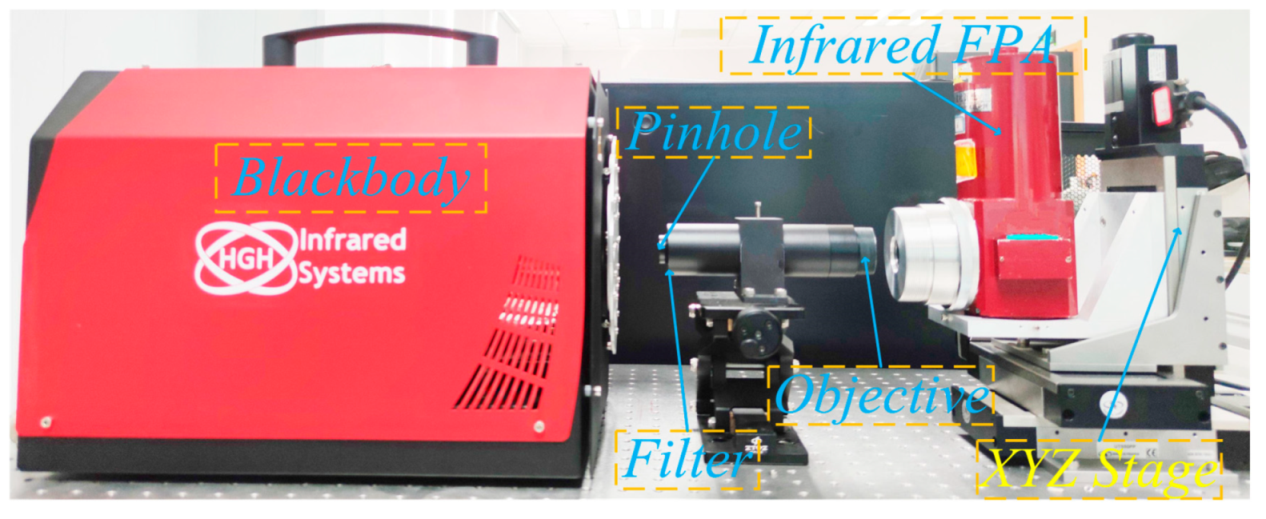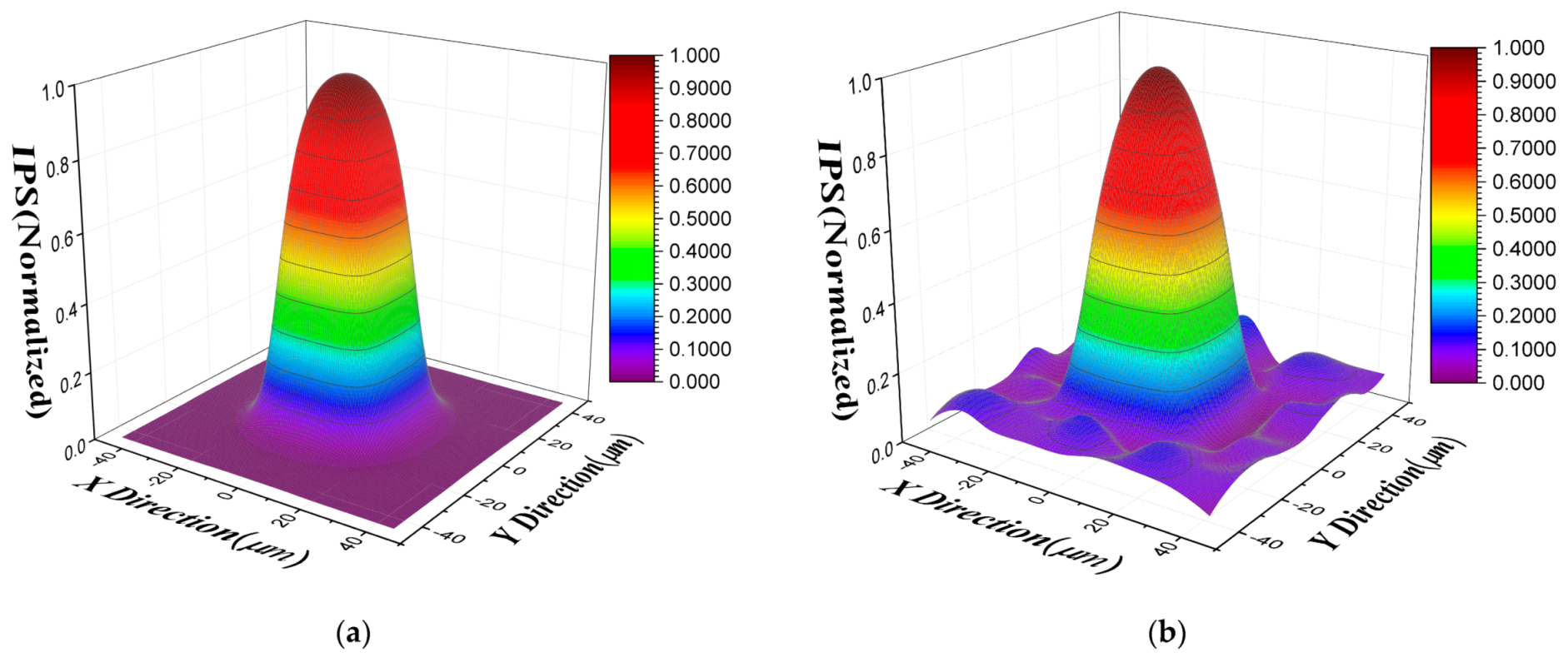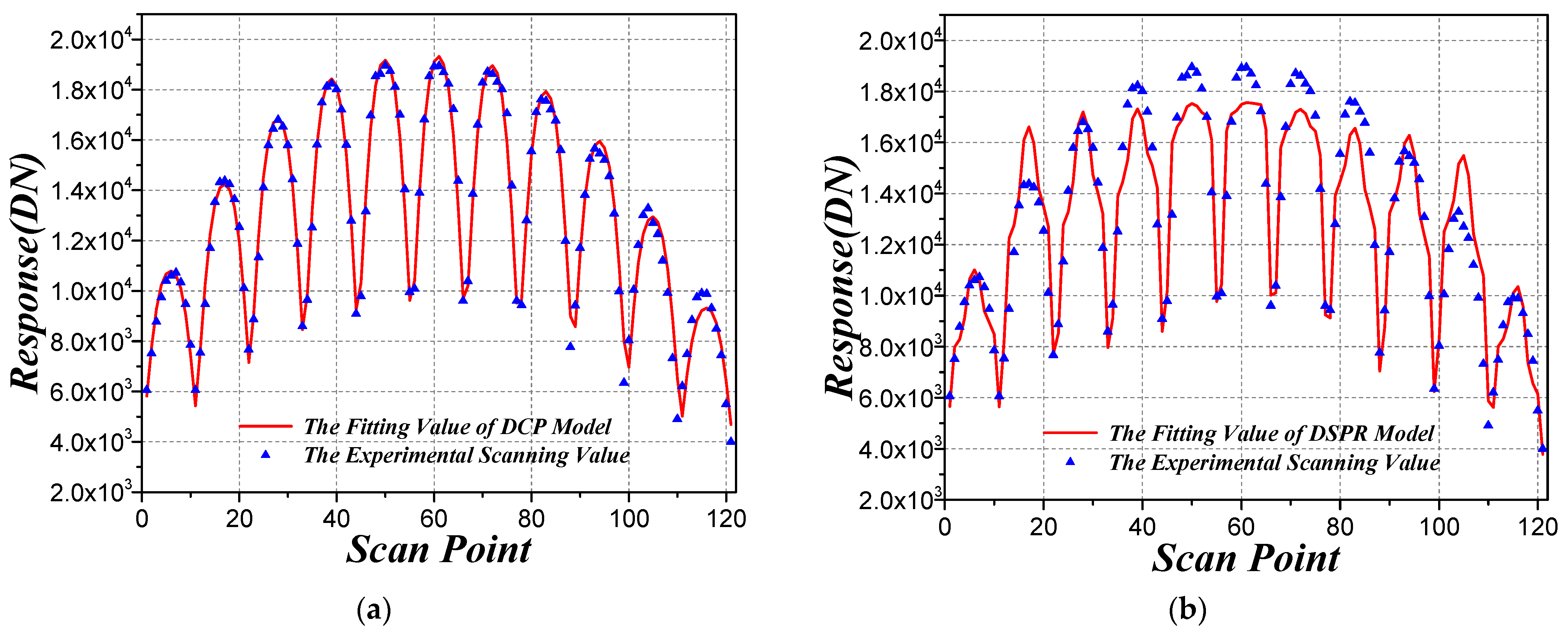Improved Intra-Pixel Sensitivity Characterization Based on Diffusion and Coupling Model for Infrared Focal Plane Array Photodetector
Abstract
:1. Introduction
2. Materials and Methods
2.1. Experimental Setup
2.2. Improved IPS Model Based on the DCP
2.3. Parameters Solving of IPS Based on the DCP
3. Results and Discussion
3.1. Evaluation Criteria
3.2. Simulation Results
3.3. Experimental Results
4. Conclusions
Author Contributions
Funding
Institutional Review Board Statement
Informed Consent Statement
Data Availability Statement
Conflicts of Interest
References
- Fazio, G.; Hora, J.; Allen, L.; Ashby, M.; Barmby, P.; Deutsch, L.; Huang, J.-S.; Kleiner, S.; Marengo, M.; Megeath, S. The infrared array camera (IRAC) for the spitzer space telescope. Astrophys. J. Suppl. Ser. 2004, 154, 10. [Google Scholar] [CrossRef] [Green Version]
- Gardner, J.P.; Mather, J.C.; Clampin, M.; Doyon, R.; Greenhouse, M.A.; Hammel, H.B.; Hutchings, J.B.; Jakobsen, P.; Lilly, S.J.; Long, K.S. The james webb space telescope. Space Sci. Rev. 2006, 123, 485–606. [Google Scholar] [CrossRef] [Green Version]
- Howell, S.B.; Koehn, B.; Bowell, E.; Hoffman, M. Detection and measurement of poorly sampled point sources imaged with 2-D array. Astron. J. 1996, 112, 1302. [Google Scholar] [CrossRef]
- Lauer, T.R. The Photometry of Undersampled Point-Spread Functions. Publ. Astron. Soc. Pac. 1999, 111, 1434. [Google Scholar] [CrossRef] [Green Version]
- Anderson, J.; King, I.R. Toward High-Precision Astrometry with WFPC2. I. Deriving an Accurate Point-Spread Function. Publ. Astron. Soc. Pac. 2000, 112, 1360. [Google Scholar] [CrossRef]
- Sodnik, Z.; Cugny, B.; Karafolas, N.; Guérineau, N.; de la Barrière, F.; Boulade, O.; Viale, T.; Ketchazo, C.; Delisle, C.; Druart, G.; et al. Intrapixel Measurement Techniques on Large Focal Plane Arrays for Astronomical Applications: A Comparative Study. In Proceedings of the International Conference on Space Optics—ICSO, Biarritz, France, 18–21 October 2016; p. 112. [Google Scholar]
- Willemin, M.; Blanc, N.; Lang, G.; Lauxtermann, S.; Schwider, P.; Seitz, P.; Wäny, M. Optical characterization methods for solid-state image sensors. Opt. Lasers Eng. 2001, 36, 185–194. [Google Scholar] [CrossRef]
- Takacs, P.; Kotov, I.; Frank, J.; O’Connor, P.; Radeka, V.; Lawrence, D. PSF and MTF Measurement Methods for Thick CCD Sensor Characterization. In Proceedings of the High Energy, Optical, and Infrared Detectors for Astronomy IV, San Diego, CA, USA, 27 June–2 July 2010; Volume 7742. [Google Scholar]
- Ketchazo, C.; Viale, T.; Boulade, O.; Druart, G.; Moreau, V.; Mugnier, L.; Dubrueil, D.; Derelle, S.; Ronayette, S.; Guérineau, N.; et al. A new technique of characterization of intrapixel response dedicated to astronomical detectors. Nucl. Instrum. Methods Phys. Res. Sect. A Accel. Spectrometers Detect. Assoc. Equip. 2015, 787, 265–269. [Google Scholar] [CrossRef]
- Holland, A.D.; Beletic, J.; Viale, T.; Ketchazo, C.; Guérineau, N.; Boulade, O.; de la Barrière, F.; Moreau, V.; Mugnier, L.; Dubreuil, D.; et al. High Accuracy Measurements of the Intrapixel Sensitivity of VIS to LWIR Astronomical Detectors: Experimental Demonstration. In Proceedings of the High Energy, Optical, and Infrared Detectors for Astronomy VII, Edinburgh, UK, 26 June–1 July 2016; Volume 9915, p. 991517. [Google Scholar]
- Ivory, J.; Stefanov, K.D.; Turner, P.; Holland, A.D. PSF and Non-Uniformity in a Monolithic Fully Depleted 4T CMOS Image Sensor. In Proceedings of the High Energy, Optical, and Infrared Detectors for Astronomy VIII, Austin, TX, USA, 10–15 June 2018; p. 1070928. [Google Scholar]
- Hu, Z.; Su, X.; Li, X.; Zhang, L.; Chen, F. A method for the characterization of intra-pixel response of infrared sensor. Opt. Quantum Electron. 2019, 51, 74. [Google Scholar] [CrossRef]
- Kavaldjiev, D.; Ninkov, Z. Subpixel sensitivity map for a charge-coupled device. Opt. Eng. 1998, 37, 948–954. [Google Scholar] [CrossRef]
- Piterman, A.; Ninkov, Z. Subpixel sensitivity maps for a back-illuminated charge-coupled device and the effects of nonuniform response on measurement. Opt. Eng. 2002, 41, 1192–1202. [Google Scholar] [CrossRef]
- Soehnel, G.; Tanbakuchi, A. Simulation and experimental characterization of the point spread function, pixel saturation, and blooming of a mercury cadmium telluride focal plane array. Appl. Opt. 2012, 51, 7987–7993. [Google Scholar] [CrossRef]
- Vorobiev, D.; Irwin, A.; Ninkov, Z.; Donlon, K.; Caldwell, D.; Mochnacki, S. Direct measurement of the Kepler Space Telescope CCD’s intrapixel response function. J. Astron. Telesc. Instrum. Syst. 2019, 5, 1. [Google Scholar] [CrossRef]
- Mahato, S.B.; de Ridder, J.; Meynants, G.; Raskin, G.; van Winckel, H. Measuring Intra-Pixel Sensitivity Variations of a CMOS Image Sensor. IEEE Sens. J. 2018, 18, 2722–2728. [Google Scholar] [CrossRef] [Green Version]
- Niemi, S.-M.; Cropper, M.; Szafraniec, M.; Kitching, T. Measuring a charge-coupled device point spread function. Exp. Astron. 2015, 39, 207–231. [Google Scholar] [CrossRef] [Green Version]
- Vishnyakov, A.V.; Stuchinsky, V.A.; Brunev, D.V.; Zverev, A.V.; Dvoretsky, S.A. Determination of charge-carrier diffusion length in the photosensing layer of HgCdTe n-on-p photovoltaic infrared focal plane array detectors. Appl. Phys. Lett. 2014, 104, 092112. [Google Scholar] [CrossRef]
- Vishnyakov, A.V.; Stuchinsky, V.A.; Brunev, D.V.; Zverev, A.V.; Dvoretsky, S.A. Analysis of charge-carrier diffusion in the photosensing films of HgCdTe infrared focal plane array photodetectors. J. Appl. Phys. 2015, 118, 124508. [Google Scholar] [CrossRef]
- Barron, N.; Borysow, M.; Beyerlein, K.; Brown, M.; Lorenzon, W.; Schubnell, M.; Tarlé, G.; Tomasch, A.; Weaverdyck, C. Subpixel response measurement of near-infrared detectors. Publ. Astron. Soc. Pac. 2007, 119, 466. [Google Scholar] [CrossRef] [Green Version]
- Biesiadzinski, T.; Tarlé, G.; Howe, M.; Schubnell, M.; Lorenzon, W.; Weaverdyck, C.; Larson, J. A method for the characterization of sub-pixel response of near-infrared detectors. In Proceedings of the High Energy, Optical, and Infrared Detectors for Astronomy IV, San Diego, CA, USA, 27 June–2 July 2010; Volume 7742. [Google Scholar]
- Schuster, J.; Bellotti, E. Numerical simulation of crosstalk in reduced pitch HgCdTe photon-trapping structure pixel arrays. Opt. Express 2013, 21, 14712–14727. [Google Scholar] [CrossRef] [PubMed]
- Vallone, M.; Goano, M.; Bertazzi, F.; Ghione, G.; Schirmacher, W.; Hanna, S.; Figgemeier, H. Simulation of small-pitch HgCdTe photodetectors. J. Electron. Mater. 2017, 46, 5458–5470. [Google Scholar] [CrossRef]
- Appleton, B.; Hubbard, T.; Glasmann, A.; Bellotti, E. Parametric numerical study of the modulation transfer function in small-pitch InGaAs/InP infrared arrays with refractive microlenses. Opt. Express 2018, 26, 5310–5326. [Google Scholar] [CrossRef]
- Vallone, M.; Goano, M.; Bertazzi, F.; Ghione, G.; Hanna, S.; Eich, D.; Figgemeier, H. Diffusive-probabilistic model for inter-pixel crosstalk in HgCdTe focal plane arrays. IEEE J. Electron. Devices Soc. 2018, 6, 664–673. [Google Scholar] [CrossRef]
- Polovinkin, V.G.; Stuchinsky, V.A.; Vishnyakov, A.V.; Lee, I.I. Monte Carlo simulation of photoelectric characteristics of mercury–cadmium–tellurium-based infrared focal-plane-array detectors. IEEE Trans. Electron. Devices 2018, 65, 4924–4930. [Google Scholar] [CrossRef]
- Lee, I.I.; Polovinkin, V.G. Dependence of the Modulation Transfer Function on the Material and Design Parameters of HgCdTe IR FPAs. IEEE Trans. Electron. Devices 2020, 67, 3175–3179. [Google Scholar] [CrossRef]
- Coleman, T.F.; Li, Y. A reflective Newton method for minimizing a quadratic function subject to bounds on some of the variables. SIAM J. Optim. 1996, 6, 1040–1058. [Google Scholar] [CrossRef]
- Donlon, K.; Ninkov, Z.; Baum, S. Point-spread Function Ramifications and Deconvolution of a Signal Dependent Blur Kernel Due to Interpixel Capacitive Coupling. Publ. Astron. Soc. Pac. 2018, 130, 074503. [Google Scholar] [CrossRef] [Green Version]








| Equipment | Parameters | Manufacturer |
|---|---|---|
| Blackbody | Temperature range: 50~1250 °C Temperature accuracy: 0.1 °C The emissivity: >0.99 | HGH |
| Pinhole | Diameter: 5 μm | Custom |
| Filter | Wavelength: 2–2.5 μm | Thorlabs |
| Object Lens | F#: 2 Focal length: 40 mm | Custom |
| XYZ Linear Stage | Minimum increment: 0.3 μm Uni-directional repeatability: ±0.2 μm Bi-directional repeatability: ±2.2 μm | Newport |
| Spot Size (μm) | IPS Error (%) | Fitting Error (%) | ||
|---|---|---|---|---|
| DCP | DSPR | DCP | DSPR | |
| 3 | 0.63 | 3.70 | 0.90 | 7.07 |
| 6 | 3.10 | 8.78 | 0.88 | 1.18 |
| 9 | 5.96 | 7.67 | 1.03 | 1.10 |
| 12 | 6.21 | 6.34 | 0.90 | 1.32 |
| 15 | 8.92 | 10.56 | 0.74 | 0.91 |
| 18 | 13.60 | 16.56 | 0.76 | 0.80 |
Publisher’s Note: MDPI stays neutral with regard to jurisdictional claims in published maps and institutional affiliations. |
© 2021 by the authors. Licensee MDPI, Basel, Switzerland. This article is an open access article distributed under the terms and conditions of the Creative Commons Attribution (CC BY) license (https://creativecommons.org/licenses/by/4.0/).
Share and Cite
Zhong, L.; Li, X.; Zhu, M.; Hu, Z.; Chen, F. Improved Intra-Pixel Sensitivity Characterization Based on Diffusion and Coupling Model for Infrared Focal Plane Array Photodetector. Sensors 2021, 21, 8195. https://doi.org/10.3390/s21248195
Zhong L, Li X, Zhu M, Hu Z, Chen F. Improved Intra-Pixel Sensitivity Characterization Based on Diffusion and Coupling Model for Infrared Focal Plane Array Photodetector. Sensors. 2021; 21(24):8195. https://doi.org/10.3390/s21248195
Chicago/Turabian StyleZhong, Li, Xiaoyan Li, Min Zhu, Zhuoyue Hu, and Fansheng Chen. 2021. "Improved Intra-Pixel Sensitivity Characterization Based on Diffusion and Coupling Model for Infrared Focal Plane Array Photodetector" Sensors 21, no. 24: 8195. https://doi.org/10.3390/s21248195
APA StyleZhong, L., Li, X., Zhu, M., Hu, Z., & Chen, F. (2021). Improved Intra-Pixel Sensitivity Characterization Based on Diffusion and Coupling Model for Infrared Focal Plane Array Photodetector. Sensors, 21(24), 8195. https://doi.org/10.3390/s21248195







